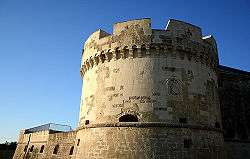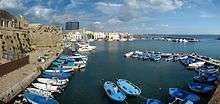Province of Lecce
| Province of Lecce | |
|---|---|
| Province | |
 Map highlighting the location of the province of Lecce in Italy | |
| Country |
|
| Region | Apulia |
| Capital(s) | Lecce |
| Comuni | 97 |
| Government | |
| • President | Antonio Maria Gabellone |
| Area | |
| • Total | 2,759 km2 (1,065 sq mi) |
| Population (2012) | |
| • Total | 814,495 |
| • Density | 300/km2 (760/sq mi) |
| Time zone | CET (UTC+1) |
| • Summer (DST) | CEST (UTC+2) |
| Postal code | 73001-73100 |
| Telephone prefix | 0832, 0833, 0836 |
| Vehicle registration | LE |
| ISTAT | 075 |
.jpg)
The Province of Lecce (Italian: Provincia di Lecce) is a province in the Apulia region of Italy. Its capital is the city of Lecce, which is known as the Florence of the South. The province itself is called the "Heel of Italy".[1] Included entirely in the Salento peninsula, it is the second most populous province in Apulia and the twenty-first in Italy.[2]
It has an area of 2,759 square kilometres (1,065 sq mi) and a total population of 814,495 (2012). There are 97 comunes (Italian: comuni) in the province. It is surrounded by the provinces of Taranto and Brindsi in the northwest, Ionian Sea in the west, Adriatic Sea in the east.[3] This location has established it as a popular tourist destination. It has been ruled by the Romans, Byzantine Greeks, Carolingians, Lombards, Arabs and Normans.[4] The important towns are Lecce, Gallipoli, Nardò, Maglie and Otranto.[5] The important agricultural products are wheat and corn.[6]
History
The province of Lecce has its origins in the ancient Giustizierato, then the Province of Terra d'Otranto. Since the eleventh century the Terra d'Otranto included the territories of the provinces of Lecce, Taranto and Brindisi (with the exception of Fasano and Cisternino). During this time the current region of Lecce was severely affected by poverty despite the production of olive oil.[7] People from Lecce migrated to the Province of Bari where they worked in the wine industry in order to earn their living.[8] Up to 1663 the Province of Terra d'Otranto also included the territory of Matera (Basilicata). Its capital was at first Otranto, but in the Norman period (twelfth century), Lecce was made the capital. After the unification of Italy, the name of Terra d'Otranto was changed to Province of Lecce and its territory was divided into the four districts of Lecce, Gallipoli, Brindisi and Taranto. Its break-up began in 1923, when the district of Taranto was transformed into the new province of the Ionian.[9] After the first world war the economic condition worsened and unemployment reached its height. These factors coupled with the negligence of the weak government prompted the farm workers to revolt against their farm owners. After being captured the farm owners were paraded in public places.[10] During the medieval era, Muslim slaves were transported from the ports located in the province and the practice of keeping slaves was common.[11] Lecce stone extracted from the province has been used in decorating several historical monuments and is widely used in interior decoration.[12]
Natural Reserve of San Cataldo is located in the province.[13] Lakes Alimini Grande and Alimini Piccolo are also located in the province.[1] Italian and Griko language are spoken by the inhabitants.[13] A few major attractions of the province are Piazza Duomo, Piazza Sant'Oronzo, Palazzo del Seggio, Church of Santa Maria delle Grazie, Castle of Charles V, Basilica di Santa Croce, Porto Cesareo, Gallipoli and Torre San Giovanni. The Natural Park of Porto Selvaggio is known for its caves.[13]
Communes
Lecce has several ethnic and linguistic minority groups. A Griko community of around 40,000 lives in the Grecia Salentina region in the central area of the province, with an Arbëreshe community in Soleto.
| Commune | Population |
|---|---|
| Lecce | 94,949 |
| Nardò | 31,195 |
| Galatina | 27,317 |
| Copertino | 24,452 |
| Gallipoli | 21,038 |
| Casarano | 20,593 |
| Tricase | 17,832 |
| Galatone | 15,850 |
| Maglie | 14,982 |
| Trepuzzi | 14,702 |
| Squinzano | 14,636 |
| Surbo | 14,494 |
| Veglie | 14,337 |
| Leverano | 14,177 |
| Monteroni di Lecce | 13,895 |
| Taviano | 12,698 |
| Taurisano | 12,682 |
| Carmiano | 12,307 |
| Ugento | 12,076 |
| Cavallino | 11,995 |
| Matino | 11,814 |
| Lizzanello | 11,376 |
| Campi Salentina | 10,925 |
| Racale | 10,806 |
Gallery
 Basilica of Santa Croce, Lecce
Basilica of Santa Croce, Lecce Piazza Duomo, Lecce
Piazza Duomo, Lecce Acaya castle
Acaya castle Otranto seaside
Otranto seaside Otranto seaside
Otranto seaside Cathedral of Otranto
Cathedral of Otranto- Torre Sant'Emiliano, not far from the Palascìa lighthouse
 Torre dell'Orso beach
Torre dell'Orso beach- 16th century tower in Torre dell'Orso
 16th century tower in Roca Vecchia
16th century tower in Roca Vecchia- Salandra square in Nardò
 Gallipoli harbour
Gallipoli harbour Le Puritate beach in Gallipoli
Le Puritate beach in Gallipoli- Cathedral of Ugento
References
- 1 2 "Province of Lecce". Understanding Italy. Retrieved 24 September 2014.
- ↑ "Statistiche demografiche ISTAT" (in Italian). demo.istat.it. 2009-12-30.
- ↑ Domenico 2002, p. 26.
- ↑ Domenico 2002, p. 27.
- ↑ Domenico 2002, p. 28.
- ↑ Macgregor 1843, p. 1171.
- ↑ Gentilcore 1992, p. 28.
- ↑ Cinel 2002, p. 181.
- ↑ "R.D. 2 settembre 1923, n. 1911 - Istituzione della provincia di Taranto" [R.D. September 2, 1923, n. 1911 - Establishment of the Province of Taranto] (in Italian). G.U. di pubblicazione. 21 November 1923. Retrieved 24 September 2014.
- ↑ Snowden 2004, p. 163.
- ↑ Mikropoulos, p. 138.
- ↑ Cassar & Winter 2014, p. 140.
- 1 2 3 "Lecce, Apulia". ITALIA. Retrieved 24 September 2014.
Bibliography
- Cassar, J.; Winter, M.G.; Marker, B.R.; N.R.G. Walton; D.C. Entwisle; E.N. Bromhead; J.W.N. Smith (2014). Stone in Historic Buildings: Characterization and Performance. Geological Society of London. ISBN 978-1-86239-376-9.
- Cinel, Dino (2002). The National Integration of Italian Return Migration, 1870-1929. Cambridge University Press. ISBN 978-0-521-52118-5.
- Domenico, Roy Palmer (2002). The Regions of Italy: A Reference Guide to History and Culture. Greenwood Publishing Group. ISBN 978-0-313-30733-1.
- Gentilcore, David (1992). From Bishop to Witch: The System of the Sacred in Early Modern Terra D'Otranto. Manchester University Press. ISBN 978-0-7190-3640-8.
- Macgregor, John (1843). Commercial Statistics: A Digest of the Productive Resources, Commercial Legislation, Customs Tariffs ... of All Nations, Including All British Commercial Treaties with Foreign States ... Nott.
- Mikropoulos, Tassos A. Elevating and Safeguarding Culture Using Tools of the Information Society: Dusty traces of the Muslim culture. Earthlab. ISBN 978-960-233-187-3.
- Snowden, Frank M. (2004). Violence and the Great Estates in the South of Italy: Apulia, 1900-1922. Cambridge University Press. ISBN 978-0-521-52710-1.
External links
| Wikimedia Commons has media related to Province of Lecce. |
Coordinates: 40°21′7.24″N 18°10′8.9″E / 40.3520111°N 18.169139°E
